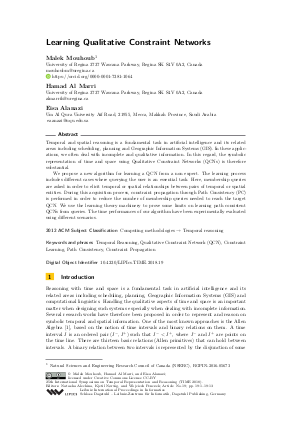Learning Qualitative Constraint Networks
Authors
Malek Mouhoub  ,
Hamad Al Marri,
Eisa Alanazi
,
Hamad Al Marri,
Eisa Alanazi
-
Part of:
Volume:
25th International Symposium on Temporal Representation and Reasoning (TIME 2018)
Part of: Series: Leibniz International Proceedings in Informatics (LIPIcs)
Part of: Conference: International Symposium on Temporal Representation and Reasoning (TIME) - License:
 Creative Commons Attribution 3.0 Unported license
Creative Commons Attribution 3.0 Unported license
- Publication Date: 2018-10-08
File

PDF
LIPIcs.TIME.2018.19.pdf
- Filesize: 438 kB
- 13 pages
Document Identifiers
Subject Classification
ACM Subject Classification
- Computing methodologies → Temporal reasoning
Keywords
- Temporal Reasoning
- Qualitative Constraint Network (QCN)
- Constraint Learning
- Path Consistency
- Constraint Propagation
Metrics
- Access Statistics
-
Total Accesses (updated on a weekly basis)
0PDF Downloads0Metadata Views
Abstract
Temporal and spatial reasoning is a fundamental task in artificial intelligence and its related areas including scheduling, planning and Geographic Information Systems (GIS). In these applications, we often deal with incomplete and qualitative information. In this regard, the symbolic representation of time and space using Qualitative Constraint Networks (QCNs) is therefore substantial. We propose a new algorithm for learning a QCN from a non expert. The learning process includes different cases where querying the user is an essential task. Here, membership queries are asked in order to elicit temporal or spatial relationships between pairs of temporal or spatial entities. During this acquisition process, constraint propagation through Path Consistency (PC) is performed in order to reduce the number of membership queries needed to reach the target QCN. We use the learning theory machinery to prove some limits on learning path consistent QCNs from queries. The time performances of our algorithm have been experimentally evaluated using different scenarios.
Cite As Get BibTex
Malek Mouhoub, Hamad Al Marri, and Eisa Alanazi. Learning Qualitative Constraint Networks. In 25th International Symposium on Temporal Representation and Reasoning (TIME 2018). Leibniz International Proceedings in Informatics (LIPIcs), Volume 120, pp. 19:1-19:13, Schloss Dagstuhl – Leibniz-Zentrum für Informatik (2018)
https://doi.org/10.4230/LIPIcs.TIME.2018.19
BibTex
@InProceedings{mouhoub_et_al:LIPIcs.TIME.2018.19,
author = {Mouhoub, Malek and Al Marri, Hamad and Alanazi, Eisa},
title = {{Learning Qualitative Constraint Networks}},
booktitle = {25th International Symposium on Temporal Representation and Reasoning (TIME 2018)},
pages = {19:1--19:13},
series = {Leibniz International Proceedings in Informatics (LIPIcs)},
ISBN = {978-3-95977-089-7},
ISSN = {1868-8969},
year = {2018},
volume = {120},
editor = {Alechina, Natasha and N{\o}rv\r{a}g, Kjetil and Penczek, Wojciech},
publisher = {Schloss Dagstuhl -- Leibniz-Zentrum f{\"u}r Informatik},
address = {Dagstuhl, Germany},
URL = {https://drops.dagstuhl.de/entities/document/10.4230/LIPIcs.TIME.2018.19},
URN = {urn:nbn:de:0030-drops-97849},
doi = {10.4230/LIPIcs.TIME.2018.19},
annote = {Keywords: Temporal Reasoning, Qualitative Constraint Network (QCN), Constraint Learning, Path Consistency, Constraint Propagation}
}
Author Details
Funding
- Mouhoub, Malek: Natural Sciences and Engineering Research Council of Canada (NSERC), RGPIN-2016-05673
References
-
James F Allen. Maintaining knowledge about temporal intervals. Communications of the ACM, 26(11):832-843, 1983.

-
Dana Angluin. Queries and concept learning. Machine Learning, 2(4):319-342, 1988.

-
R. Arcangioli and N. Lazaar. Multiple Constraint Acquisition. In Workshop on Constraints and Preferences for Configuration and Recommendation, the Twenty-Forth International Joint Conference on Artificial Intelligence, 2015.

-
Philippe Balbiani, Jean-François Condotta, and Luis Farinas del Cerro. A new tractable subclass of the rectangle algebra. In Proceedings of the 16th international joint conference on Artifical intelligence - Volume 1, pages 442-447, 1999.

-
C. Bessiere, R. Coletta, B. O'Sullivan, and M. Paulin. Query-Driven Constraint Acquisition. In Proceedings of the Twentiest International Joint Conference on Artificial Intelligence, pages 50-55, 2007.

-
Christian Bessiere, Remi Coletta, Emmanuel Hebrard, George Katsirelos, Nadjib Lazaar, Nina Narodytska, Claude-Guy Quimper, and Toby Walsh. Constraint acquisition via partial queries. In IJCAI'2013: 23rd International Joint Conference on Artificial Intelligence, page 7, 2013.

- Christian Bessiere, Frédéric Koriche, Nadjib Lazaar, and Barry O'Sullivan. Constraint acquisition. Artificial Intelligence, 244:315-342, 2017. URL: http://dx.doi.org/10.1016/j.artint.2015.08.001.
-
Christian Bliek and Djamila Sam-Haroud. Path consistency on triangulated constraint graphs. In IJCAI, volume 99, pages 456-461. Citeseer, 1999.

-
Rina Dechter. Constraint Processing. Morgan Kaufmann Publishers Inc., San Francisco, CA, USA, 2003.

-
Max J. Egenhofer and Robert D. Franzosa. Point-set topological spatial relations. International Journal of Geographical Information Systems, 5(2):161-174, 1991.

-
Sally A. Goldman and Michael J. Kearns. On the complexity of teaching. Journal of Computer and System Sciences, 50:20-31, 1995.

-
Michael J. Kearns and Umesh V. Vazirani. An Introduction to Computational Learning Theory. MIT Press, Cambridge, MA, USA, 1994.

-
Sanjiang Li and Mingsheng Ying. Region connection calculus: Its models and composition table. Artificial Intelligence, 145(1):121-146, 2003.

-
Zhiguo Long, Michael Sioutis, and Sanjiang Li. Efficient path consistency algorithm for large qualitative constraint networks. In Proceedings of the Twenty-Fifth International Joint Conference on Artificial Intelligence, pages 1202-1208. AAAI Press, 2016.

-
Roger Mohr and Thomas C Henderson. Arc and path consistency revisited. Artificial intelligence, 28(2):225-233, 1986.

-
Malek Mouhoub and Amrudee Sukpan. Managing temporal constraints with preferences. Spatial Cognition & Computation, 8(1-2):131-149, 2008.

-
Malek Mouhoub and Amrudee Sukpan. Conditional and composite temporal csps. Applied Intelligence, 36(1):90-107, 2012.

-
Peter Revesz. Tightened transitive closure of integer addition constraints. In Eighth Symposium on Abstraction, Reformulation, and Approximation, pages 136-142. AAAI, 2009.

-
Samira Sadaoui and Shubhashis Kumar Shil. A multi-attribute auction mechanism based on conditional constraints and conditional qualitative preferences. JTAER, 11(1):1-25, 2016.

-
Peter Van Beek and Dennis W Manchak. The design and experimental analysis of algorithms for temporal reasoning. Journal of Artificial Intelligence Research, 4(1):1-18, 1996.

